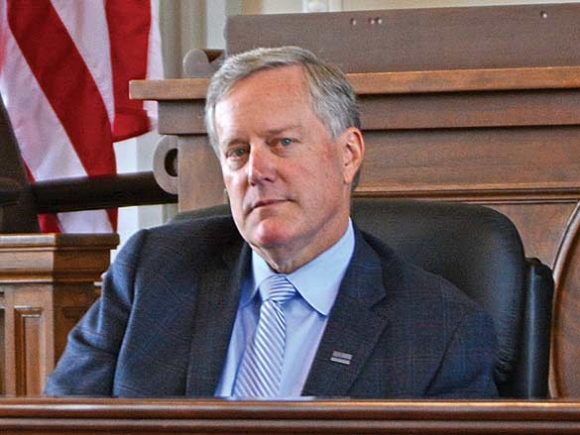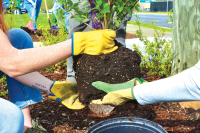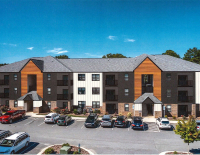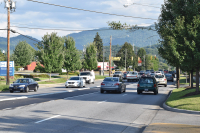Congressman sits down with wilderness supporters

Congressman Mark Meadows (R-Cashiers) and a room of 30 wilderness supporters spent two hours discussing everything from ecology to U.S. Forest Service road budgets last week at the Haywood County Historic Courthouse with the goal of better understanding each other’s views on the purpose of wilderness designation.
“I will read everything you send me. I’m going to ask you questions,” Meadows promised as he closed out the meeting. “I’m trying to be as informed as I can.”
The meeting was organized after wilderness advocates criticized Meadows for turning them away from a listening session he’d organized with county leaders across the district Aug. 30. Held in Franklin, the meeting drew a crowd of passionate wilderness supporters in addition to the invited participants, but the uninvited wilderness folks were told the meeting wasn’t open to the general public — though media representatives were allowed to sit in and report on what took place and some pro-wilderness people involved with the forest plan revision were among the invited guests. The closed door drew anger from many in the wilderness community, who felt that, because six of the seven westernmost counties had passed resolutions asking for zero additional wilderness, Meadows would be getting a one-sided story.
In response, Meadows swiftly set up the Oct. 4 meeting, to which he invited the group who’d been denied entrance to the Franklin meeting, as well as an array of pro-wilderness experts who have been active in the planning process for the Pisgah-Nantahala National Forest plan revision, which has sparked the wilderness-related discussion. The finished plan, expected by the end of 2017, will include recommendations for additional congressionally designated wilderness, which would then require an act of Congress to create.
“You’ve got two opposing views,” Meadows said of the wilderness question. “I do believe that there’s a sweet spot on some, and so having your input is critical.”
Related Items
Opposing views
The wilderness discussion is complex and multi-faceted, but at a basic level people who oppose additional wilderness believe that wilderness designation unduly limits management options, prevents creation of the young forest habitat that many species need and limits recreation access to just a select group of forest users. Pro-wilderness folks, meanwhile, say that it’s critical to set aside areas in which man will not interfere so that ecosystems can operate naturally, air and water can remain clean and humans can experience restorative solitude.
The split is wide.
“We have worked like crazy to build a common agenda,” said Alan Nicholas, supervisor for North Carolina’s national forests.
Nevertheless, the process has remained polarized, and some meeting attendees expressed frustration with that reality.
“It would be great if at some point we could have our discussions based on actual facts of what wilderness permits and what wilderness does not permit rather than setting up this either/or,” said David Reid of The Sierra Club’s North Carolina Chapter.
“I think the real ambiguity is not on the definition of wilderness. It is on the Forest Service’s implementation and on a Wilderness Study Area and what will be allowed and what will not be allowed,” Meadows said. “I’d love to see what’s the perception.”
Because only Congress can designate wilderness, the Forest Service must decide how to manage recommended wilderness areas until Congress makes a decision.
“The intent of the Wilderness Act back in 1964 was to recognize and protect areas not only for the protection of those areas but for a certain kind of experience that the authors of the Wilderness Act saw as integral to the American identity,” responded Josh Kelly, public lands biologist for MountainTrue. “It’s clear that the Wilderness Act does not permit bicycles. It does not permit mechanical equipment.”
Meanwhile, Buzz Williams of The Chattooga Conservancy confronted Meadows about legislation he’d recently introduced in Congress that would open up Wilderness Study Areas — areas identified decades ago as places that might qualify as wilderness, pending study, but had never been decided upon either way — to a variety of uses, including mountain biking. Did Meadows even really want to hear what the pro-wilderness crowd thought, Williams asked, or was it just a show?
“Why have you already made up your mind?” Williams asked. “You’ve already introduced legislation to turn those Wilderness Study Areas back to multiple use, which would destroy them. So I wonder why are we even here?”
“I introduced two pieces of legislation to get the discussion going, which is what needs to happen,” Meadows responded. “When we look at Wilderness Study Areas, Buzz, the question is how long are we going to study?”
More to the point, Meadows said, it’s important that everyone at the table define what they’re trying to accomplish when designating wilderness and think about whether there are other ways to achieve that same goal that don’t come with all the regulations attached to a bona fide wilderness designation.
“If you talk to people in Panthertown Valley (in Jackson County), they’re wanting to be able to do mountain biking there, and the same group would say ‘We want it to be wilderness’ because their idea is that would be protection of that particular habitat,” Meadows said.
However, mountain biking is not allowed in wilderness areas.
“I think that we should not think of wilderness as something to be used,” said Olga Pader, an avid hiker and past president of the Nantahala Hiking Club. “I think we should think of wilderness as the earth’s right to be.”
“Let me take that view. So your idea of wilderness is that no people should be there?” asked Meadows.
“No, no. We are visitors. We cannot remain,” Pader responded.
Another way to think about it, added Reid, is that wilderness is a place where nature, not human enjoyment, is the priority.
“If we are starting as a species even through our hiking to love a place to death, I should be willing to temporarily give up my access to that area to protect the higher good,” he said. “Protection of the resource comes first.”
The trials of negotiation
Hiker Katey Schultz took issue with the prolonged discussion of wilderness’ definition.
“I’m a little bit concerned about starting the conversation with the idea that a lot of the experts in this room don’t know what wilderness means,” she said. “I would really like it if we could start with solving some problems rather than making it appear as though people who care about this topic don’t agree with each other.”
“The question is not as much trying to creation division as it is trying to create a definition to say if this is the definition of wilderness, is there another definition of other areas that are special and need to be protected but don’t necessarily need a wilderness designation,” Meadows said.
Maybe, said Brent Martin, regional director for The Wilderness Society’s office based in Sylva, but wilderness definitely has its place, and resolutions that many Western North Carolina counties have passed in blanket opposition to any new wilderness designation aren’t helping either.
“What we came out of after almost three years meeting with the mountain biking community trying to hash these things out was they agreed to support 109,000 acres of wilderness where there are no mountain biking trails,” Martin said. “I think those county resolutions make it even more difficult for the Forest Service to negotiate.”
The Wilderness Society was one of the diverse groups that was part of the Nantahala-Pisgah Forest Partnership, a group formed to talk about differing priorities for the new forest plan before the Forest Service even started the process. In 2015, as disagreements became heated in the Forest Service’s initial planning meetings, the Forest Service spurred the creation of the Stakeholders Forum for the Pisgah and Nantahala Forest Plan Revision, which includes about 30 members representing a range of interests.
“A lot of us in the Forum have embraced the full range of multiple uses for the forest, but there is a segment who totally opposes any consideration of wilderness,” said Hugh Irwin, land conservation planner for The Wilderness Society and member of the forum.
“Why do you think that is?” asked Meadows.
“I think it’s both a philosophical problem that the stakeholder forum has but also a fundamental misunderstanding of how multiple uses should play out in the national forest,” Irwin responded.
Perhaps the fundamental misunderstanding has to do with each side’s perceptions of the other side’s goals, Meadows said.
“There’s one group who believes that the other side will harvest timber on everything and the other side believes they’ll preserve everything,” he said. “From a stakeholder’s perspective, is that a factor or not?”
“If you’re asking me why we haven’t been able to get across the hump and figure out that we don’t disagree about those other areas, you’re asking the wrong man,” replied Sam Evans of the Southern Environmental Law Center, who is a member of the forum.
Political capital
But in all seriousness, attendees told Meadows, the Pisgah-Nantahala could indeed stand to have some additional wilderness. Across the United States, about 5 percent of the landmass — entire landmass, not just federal land — is designated wilderness. Across the Pisgah-Nantahala National Forest, about 6.6 percent of the land is wilderness.
“In the West, some forests have very high representations of wilderness, over 20 percent,” Irwin said. “The Nantahala-Pisgah is very low and we don’t have full representation of different ecosystems.”
However, wilderness is simply more abundant in the West, with 95 percent of the acres in the National Wilderness Preservation System lying west of the Mississippi River. Still, meeting attendees said, the numbers indicate that the forest could stand for some additional designation, though in the end it’s not really about the numbers.
“It’s not about the percentage. It’s about the places,” Kelly said.
“If we don’t err to the side of capturing the right areas, 15 to 20 years from now those areas will be in a less situation to be untrammeled,” added Bill Van Horne, a member of both the Franklin Appalachian Trail Community Committee and the Nantahala Hiking Club.
As the meeting drew to an end, attendees wanted to know where Meadows fell on the issue. In a September interview with The Smoky Mountain News, Meadows said that he didn’t “plan to introduce a resolution that would support additional wilderness based on the input I have right now.”
“Are you willing to go to bat for these areas if they’re controversial?” Evans asked. “We’re trying to get to a place as stakeholders working together where there’s mutual support, where we’re seeing support for things getting across the finish line for our friends and our colleagues. I think we can get there. Your bill (allowing multiple-use in wilderness study areas) isn’t making it any easier for us.”
“We have to have these kinds of discussions in order to come up with anything that matters,” Meadows replied. “I’m willing to invest political capital on both ends of the spectrum.”
A draft forest plan is expected by spring 2017, with a final version approved by the end of 2017.









